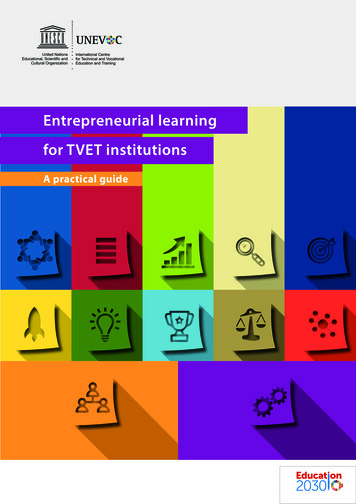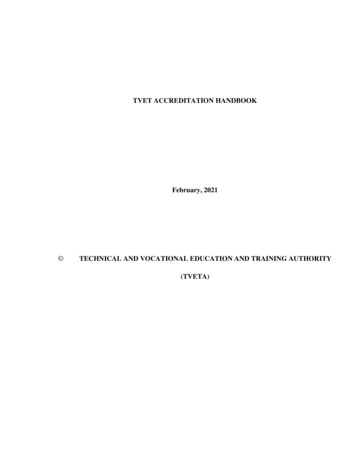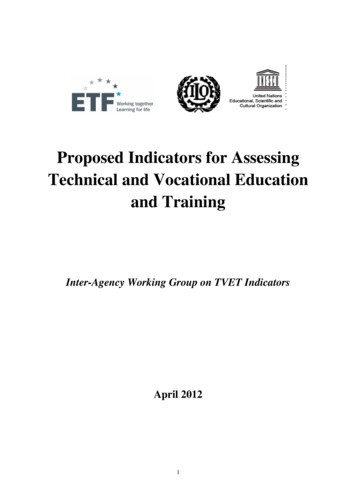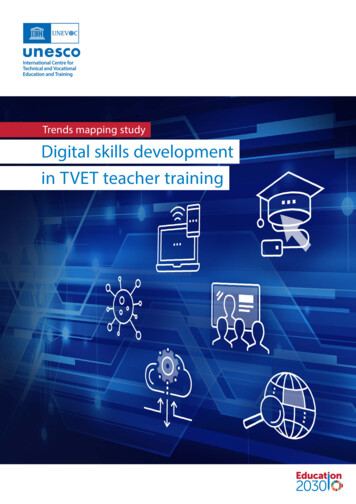
Transcription
Entrepreneurial learningfor TVET institutionsA practical guide
Entrepreneurial learningfor TVET institutionsA practical guide
Published in 2020 by theUnited Nations Educational,Scientific and Cultural Organization7, place de Fontenoy75352 Paris 07 SPFranceThis publication is available in Open Access underthe Attribution-ShareAlike 3.0 IGO (CC-BY-SA3.0 IGO) license /). By using the content ofthis publication, the users accept to be boundby the terms of use of the UNESCO Open AccessRepository -en).andUNESCO-UNEVOC InternationalCentre for Technical and VocationalEducation and TrainingUN CampusPlatz der Vereinten Nationen 153113 BonnGermany UNESCO 2020The designations employed and the presentation ofmaterial throughout this publication do not implythe expression of any opinion whatsoever on thepart of UNESCO concerning the legal status of anycountry, territory, city or area or of its authorities,or concerning the delimitation of its frontiers orboundaries.ISBN: 978-92-3-100425-4 (print/pdf )The ideas and opinions expressed in this publicationare those of the authors; they are not necessarilythose of UNESCO and do not commit theOrganization.Main authorJohannes LindnerDesignChristiane MarweckiPrintPrinted in GermanyEntrepreneurial learning for TVET institutions. A practical guide3
AcknowledgementsThis practical guide was written by JohannesLindner, Head of the Centre for EntrepreneurshipEducation as Innovation in Schools (e.e.si), AustrianFederal Ministry of Education, Science and Researchand Initiative for Teaching Entrepreneurship (IFTE),and Centre for Entrepreneurship Education andvalue-based Business Didactics of the UniversityTeacher College, Vienna/Krems, who also developedits methodology, with contributions from FrancescaBeddie of Make Your Point (Australia).The publication is the result of a collaborative effortand reflects the contributions of nine membersof the UNEVOC Network – a global platform oftechnical and vocational education and training(TVET ) institutions– who supported the codevelopment, peer review and validation of theEntrepreneurial Learning Institution Canvas (ELIC).UNESCO-UNEVOC wishes to express special thanksto the following experts from these UNEVOCCentres: Raja Chaieb, CENAFFIF - Centre Nationalde Formation de Formateurs et d’Ingenierie deFormation (Tunisia); Anshika Kushwaha, NSDC National Skill Development Corporation (India);Paolo Nardi, Cometa Formazione (Italy); LuisFernando Cateura, Fundación Paraguaya (Paraguay);Pablo Vaillant, Duoc UC (Chile); Chunlin Huangand Zheng Gangqiang, ZJTIE - Zhejiang TechnicalInstitute of Economics (China); Masaudu KazaureAdamu, Amina Idris and Abdu Isa Kofarmata, NBTE– National Board for Technical Education (Nigeria);Sibusiso Moyo and Grace Ngcobo Nontokozo, DUT Durban University of Technology (South Africa); andJosé Ramón Gómez, Pili Alonso Suarez and SusanaEspilla, Tknika - The Basque Centre of Research andApplied Innovation in VET (Spain). UNESCO-UNEVOCalso extends its sincere appreciation to MariavittoriaGarlappi, ETF - European Training Foundation, whocontributed her knowledge and expertise.4Entrepreneurial learning for TVET institutions. A practical guideThe concept and different steps of the ELIC wereelaborated and tested by the above-mentionedpartners at a UNESCO-UNEVOC workshop held inBasque Country, Spain, on 12-14 February 2020.UNESCO-UNEVOC is grateful to TKNIKA for hostingthe event.In addition, UNESCO-UNEVOC would like tothank the following experts for their feedbackand contributions: Eva Jambor, IFTE - Initiative forTeaching Entrepreneurship (Austria), Katharine Kiss,Federal Ministry of Education, Science and Research(Austria); Inge Koch-Polagnoli, e.e.si – Centrefor Entrepreneurship Education as Innovationin Schools of the Federal Ministry of Education,Science and Research (Austria); and Ivan A. Sandjaja,Global Entrepreneurship Network (Indonesia).The publication also benefited from peer review byUNESCO staff, namely Hélène Guiol, Wouter de Regtand Pooja Gianchandani.The overarching work was overseen andcoordinated by Miki Nozawa and Nickola Browne,UNESCO-UNEVOC.
IntroductionEntrepreneurial learning has never been moreimportant. The growing youth population, risingunemployment in many countries, changesin the labour market and in our economy dueto technological developments are just someof the reasons why we must provide futuregenerations with the entrepreneurial skills andmindsets they need to cope with a changingworld. Entrepreneurial learning is the basis for thecreative, innovative ideas we need to succeedin the 21st century. It is also a way we can fosterthe education and training of resilient lifelonglearners able to respond to social, economicand ecological disruption. The importance ofentrepreneurial skills to better equip youth foremployment is well reflected in the commitmentsmade by the international community. TheSustainable Development Goal 4 on Education,through one of its 10 targets, explicitly calls forthe need to strengthen ‘skills for employment,decent jobs and entrepreneurship’. Furthermore,Sustainable Development Goal 8 to promote ‘fulland productive employment and decent work forall’ emphasizes development-oriented policies thatsupport productive activities, decent job creation,entrepreneurship, creativity and innovation.Fostering youth employment and entrepreneurshipis one of the three thematic priorities underUNESCO’s Strategy for technical and vocationaleducation and training (TVET ) (2016-2021).UNESCO-UNEVOC believes that entrepreneuriallearning offers a realistic and effective meansto develop the transferable skills needed in thischanging world, and leaders and practitioners ofTVET institutions can play an important role. Tohelp TVET institutions form the entrepreneurialmindset and values that are important for people’slives, economic development and a sustainablesociety, UNESCO–UNEVOC has developed thispractical guide on how to introduce entrepreneuriallearning where it is lacking, and how to mainstreamit in vocational training. TVET can take place atsecondary, post-secondary and tertiary levels. Itis integral to lifelong learning and includes workbased learning, continuing formal and informaltraining and professional development, which maylead to qualifications.Reorienting a TVET institution towards producinggraduates with an entrepreneurial mindset canbring benefits to the institution as well as theindividual, and serve to increase the relevance andstatus of the institution in its local community.Entrepreneurial learning entails solving real-worldproblems. While these can, to a certain degree,be simulated in a classroom, the more effectiveapproach is to build a learning ecosystem thatinvolves students, teachers, employers and othersocial partners. Students can acquire skills forwork and life; teachers retain and expand theirindustry connections; employers can partner withTVET institutions to solve workplace issues and toinnovate; and communities can benefit from socialenterprises initiated with or by TVET students.This guide has been designed primarily to supportTVET teachers and managers and leaders, butalso company trainers, young and adult trainees,curriculum developers and decision makers. It hasthree parts:An introduction to entrepreneuriallearning and the basic concepts.A self-assessment tool for TVET institutionsto understand where they stand in termsof integrating entrepreneurial learning.A guide to integrating entrepreneuriallearning into TVET institutions usingthe Entrepreneurial Learning InstitutionCanvas (ELIC). ELIC is a conceptual tool forstrengthening entrepreneurial learningat the institutional level. You can answersome or all of the questions posed in thissection and learn from examples of whatothers are doing. Together your answerswill help you to develop or refine anapproach to entrepreneurial learning atyour TVET institution.This guide has benefitted from discussions with,and the experiences shared by, experts fromselected member institutions of UNESCO’s globalplatform of TVET institutions, the UNEVOC Network,in Austria, Chile, China, India, Italy, Nigeria, Paraguay,South Africa, Spain and Tunisia1, as well as theEuropean Training Foundation (ETF).1 The countries are listed in alphabetical order.Entrepreneurial learning for TVET institutions. A practical guide5
Table of ng the basic concepts12345BWhat is entrepreneurship?What is entrepreneurial learning?Why is entrepreneurial learning important?What is an entrepreneurial TVET institution?What are the key components of an entrepreneuriallearning ecosystem?Making a self-assessment1.At which stage in entrepreneurial learning is your TVETinstitution?C61011131619202223Initiating and strengthening entrepreneuriallearning in TVET26What are the main components of the EntrepreneurialLearning Institution Canvas (ELIC)? What does ELIC do?How can ELIC be used?271Value PropositionWhat is the value proposition: the value entrepreneuriallearning produces for learners and the TVET institution?322Target GroupWho are your target groups for entrepreneurial learning?363Entrepreneurial CompetenciesWhich entrepreneurial competencies should bestrengthened in the TVET learner?40Entrepreneurial learning for TVET institutions. A practical guide
C4Curriculum ApproachHow can entrepreneurial learning be integratedinto curricula?435Key ActivitiesWhat methods exist to develop entrepreneurialcompetencies?506Key ResourcesWhat resources are needed?667Core TeamWho is the driver of the implementation ofentrepreneurial learning at the institution?688Key StakeholdersWho are the key stakeholders?729AssessmentHow can entrepreneurial competencies be tested?7610ChannelsHow are the benefits of entrepreneurial learningcommunicated?8211Organizational StructuresHow can the institution support entrepreneurial learningorganizationally?8512Key Metrics and MonitoringHow can the development of entrepreneurial competenciesbe monitored? Which indicators can be used to evaluateimpact?90Conclusion and next steps92References93Entrepreneurial learning for TVET institutions. A practical guide7
Figures, boxesFIGURESFIGURE 1FIGURE 2FIGURE 3FIGURE 4FIGURE 5FIGURE 6FIGURE 7FIGURE 8FIGURE 9FIGURE 10FIGURE 11FIGURE 12FIGURE 13FIGURE 14Six core elements of entrepreneurshipOverlapping steps in the process of entrepreneurship educationTRIO model of entrepreneurial educationThe micro and macro views of TVET, with the school at the centreof the entrepreneurial learning ecosystem12 ELIC steps to achieve entrepreneurial learningConcept development from the starting point to actual projectimplementationSuggested sequencing for the 12 ELIC steps to achieve entrepreneuriallearningBasic questions institutions can ask themselves as they developentrepreneurial learningThe EntreComp conceptFramework of references for entrepreneurship competenciesVariants of curricular integration of entrepreneurial learningVET applied research developmental frameworkThe constructive alignment processCriteria for e.e.si-Entrepreneurship Schools11131420Entrepreneurial competencies can bring benefits to all spheres of lifeParaguay’s example: Self-sufficiency skills to lift the disadvantagedout of povertyCanada’s example: drivers of an ecosystem of innovationIndia offers a national perspective and policy framework on value propositionEntrepreneurship training for women and refugees: a combination ofinterventions and a tailored approach work bestThe integration of entrepreneurial learning into curricula: example from ChileThe integration of entrepreneurial learning into curricula: example from ChinaThe integration of entrepreneurial learning into curricula: example fromNigeriaThe Cometa Learning Process Model: an entrepreneurial learning productionschool in ItalyPromoting an entrepreneurial learning culture with school companies in theclassroom: the Ikasenpresa model in SpainThe Schumpeter Start-up Academy: an entrepreneurial learning school modelin AustriaGoing online: being entrepreneurial about entrepreneurial learning in IndiaThe incubator programme: an example of entrepreneurial learning models inSouth AfricaTypes of stakeholders and how to involve them: an example from FundaciónParaguayaA formative assessment pilot project for entrepreneurial learning in TunisiaA transversal examination for the entrepreneurial mindset course:an example of entrepreneurial assessment from Chile151827282930414245718088BOXESBOX 1BOX 2BOX 3BOX 4BOX 5BOX 6ABOX 6BBOX 6CBOX 7BOX 8BOX 9BOX 10BOX 11BOX 12BOX 13BOX 148Entrepreneurial learning for TVET institutions. A practical guide1933374748495354555657757981
Tables, worksheetsTABLESTABLE 1TABLE 2TABLE 3TABLE 4TABLE 5Rationale and benefits of developing an entrepreneurial mindsetStages for transforming a TVET institution into an entrepreneuriallearning ecosystemDidactic and entrepreneurial learning modesOverview of entrepreneurial learning modules, based on theTRIO-model approachDifferent assessment possibilities for entrepreneurial learning1623515978WORKSHEETSWORKSHEET 1AWhy do you want to mainstream entrepreneurial learning?WORKSHEET 1BWhich approach to entrepreneurial learning do you want tomainstream?WORKSHEET 2AWho is your target for entrepreneurial learning in TVET?WORKSHEET 2BWhat do you know about your target group?WORKSHEET 3Which competencies would be important for your target group?WORKSHEET 4AWhich phases of entrepreneurial development will you address?WORKSHEET 4BVariations of curricular integration of entrepreneurial learningWORKSHEET 4CAnalyse in which learning areas curricular measures should be takenWORKSHEET 5AAnalyse the practical examples in this chapter on the methods ofentrepreneurial learningWORKSHEET 5BOverview of entrepreneurial learning modulesWORKSHEET 6What resources are available and what is possible?WORKSHEET 7AWho is the driver of the implementation of entrepreneurial learningin a TVET institution?WORKSHEET 7BWhat is the role of entrepreneurship teachers?WORKSHEET 8AWho are the key stakeholders?WORKSHEET 8BWhat is the role of the different key stakeholders to promoteentrepreneurial learning?WORKSHEET 9What kind of assessment does entrepreneurial learning require?WORKSHEET 10A Prioritize your stakeholder relationshipsWORKSHEET 10B Create an ABC list for successful communication with the target groupand stakeholdersWORKSHEET 11A Which organizational elements have you integrated, or will youintegrate?WORKSHEET 11B Entrepreneurial learning institution certificateWORKSHEET 12Which indicators can be used to evaluate the impact of theentrepreneurial learning 91Entrepreneurial learning for TVET institutions. A practical guide9
APARTUnderstanding the basic concepts
1. What is entrepreneurship?The terms entrepreneur and entrepreneurshipderive from the French word entreprendre,(to undertake). The current meaning of theentrepreneur as an independent protagonistwas introduced in 1911 by the economistJoseph Schumpeter. According to Schumpeter,entrepreneurs are the key drivers of economicand social dynamics in society because they canindependently develop and implement ideas. Thisinnovative power encompasses the creation of newproducts, production processes, organizationalstructures or alternative distribution channels.Entrepreneurs play a relevant role in all parts ofour society: from business, religion, science andpolitics to education and sports. Generally speaking,anybody has the potential to become moreinnovative and self-reliant, especially if they areexposed to entrepreneurial learning (Faltin, 2013).While the term ‘entrepreneur’ is usually associatedwith someone who sets up their own business,it has a broader application. Entrepreneurshipsupports individuals operating in their everydaylives and in the workplace to be aware of thecontext of their work and be able to seizeopportunities (European Commission, 2006, p.4.).The terms ‘intrapreneurs’ (Pinchot, 1985) and‘co-entrepreneurs’ describe entrepreneurs whoare not self-employed but decide to becomeentrepreneurially active within an organization.‘Social entrepreneurs’ or ‘changemakers’ (Drayton,2006) are individuals who combine entrepreneurialand social initiatives to bring about a positivechange in society. They implement ideas in areassuch as education, environmental protection orthe creation of jobs for persons with disabilities(Mycoskie, 2011; Sivers, 2015).FIGURE 1 Six core elements of entrepreneurshipENTREPENEURSHIP AS A MINDSET, PROCESS AND METHODCHECKMY OWNPOTENTIALSEEOPPORTUNITIESDEVELOPIDEAS WITHVALUEIDENTIFYAND AVOIDRISKSKNOW THENECESSARYRESOURCESPUT IDEASINTO ACTION PROBLEMS TRENDS CHANGE OF LAWS TECHNICALDEVELOPMENT MARKETSource: Adapted from Lindner, 2018Entrepreneurial learning for TVET institutions. A practical guide11
The six core elements of the entrepreneurshipchecklist:(1) Check your own potential: Everyone shouldbe able to develop their own potential topursue their wishes, hopes, dreams and talents.Entrepreneurship combines all these elementsinto a mindset, a process and a set of principles ormethod (see Figure 1).a)(2) See opportunities: A central part ofentrepreneurship is identifying opportunities.This requires an outward looking orientationand the ability to stay attuned to a changingenvironment. Entrepreneurs see problemsand develop solutions to them; identify trendsand opportunities arising from changesbrought about, for example, by legislation ortechnical or market developments; or createproduct or process improvements based ontheir experience (Kirzner, 1973; Shane andVenkataraman, 2000).(3) Develop ideas with value: Schumpeter(1911) saw the value in innovative solutions:introducing new products, productionmethods, markets and organizational forms,or combinations of these, adds value forindividuals as well as society, and raisesawareness for social and commercialopportunities. The value that is created can befinancial, cultural or social (Johannisson andNilsson, 1989).(4) Identify and avoid risks: Entrepreneurs arenot adventurers. They aim to deal competentlywith risks (Drucker, 1986).(5) Know the necessary resources:Entrepreneurial efforts require the mobilizationof a wide range of resources, such as knowhow, skills and passion, networking, capital, thenecessary equipment and facilities (Ries, 2011;Faltin, 2013).(6) Put ideas into action: An individual’sability to turn ideas into action underpinsentrepreneurship. People must also be able toplan and manage projects in order to achieveobjectives (European Commission, 2005;2006, p.4.) while also marshalling ‘people andresources to create, develop and implementsolutions to problems to meet people’s needs’(Timmons et. al., 1977, p.4).12Entrepreneurial learning for TVET institutions. A practical guideEntrepreneurship as a mindset. Anentrepreneurial mindset consists of interrelatedbeliefs and assumptions that inform ourdecisions and guide our behaviour. Such amindset can be cultivated and enhancedthrough entrepreneurial learning (Duckworthet. al., 2007; Dweck, 2007). It is a way ofcreative thinking that helps a personovercome challenges, be decisive andaccept responsibility. It also drives them toimprove their skills, learn from mistakes andtake continuous action on ideas (Rae, 1999).Developing an entrepreneurial mindset andspirit is something everyone, not just businesspeople, can benefit from.b) Entrepreneurship as a process. It is adynamic process, consisting of different phases(Kuratko and Hodgetts, 1998). The first involvesidentifying possibilities and one’s own potential– without regard for the resources an individualcurrently controls (Stevenson and Jarillo, 1990;Ronstadt, 1985). This is the starting point fordeveloping new ideas that create value for anindividual, a company or society. Next comesdeveloping a concept and, finally, putting itinto practice.c)Entrepreneurship as a method.Entrepreneurial method is a way of thinking andacting that is built on a set of guidelines aboutthe mechanisms underlying entrepreneurialaction (Neck and Green, 2011; Connor et al,2018; Sarasvathy and Venkataraman, 2011), suchas effecting change or experimenting with newways of doing things.
2. What is entrepreneurial learning?Different definitions can apply in different countriesand at different levels and phases of education(Gibb and Nelson, 1996; European Commission,2011; Guzmán and Liñán, 2005; UNESCO-UNEVOC,2019a). The term ‘entrepreneurship education’can refer to learning to become entrepreneurial(cultivating a mindset), learning to become anentrepreneur to create a venture (acquiring skillsand knowledge) and becoming an entrepreneur byfounding a venture (entrepreneurship as practice).Figure 2 demonstrates the interrelationships.Entrepreneurial learning, also called entrepreneurialor entrepreneurship education,2 seeks ‘to fosterself-esteem and confidence by drawing on theindividual’s talents and creativity, while buildingthe relevant skills and values that will assist learnersin expanding their perspectives on schooling andopportunities beyond. Methodologies are basedon the use of personal, behavioural, motivational,attitudinal and career planning activities’ (UNESCO/ILO, 2006, p.22). The European CommissionThematic Working Group on EntrepreneurshipEducation has developed a definition, agreed uponby representatives from the European TrainingFoundation (ETF), the German Corporation forInternational Cooperation (GIZ), the InternationalLabour Organization (ILO), and UNESCO andthe UNESCO-UNEVOC International Centre forTVET (UNESCO-UNEVOC, 2012, p.8; EuropeanCommission, 2014b, p.3) based on this broadunderstanding:Entrepreneurship education is about learnersdeveloping the skills and mindset to be ableto turn creative ideas into entrepreneurialFIGURE 2 Overlapping steps in the process of entrepreneurship educationENTREPRENEURIALLEARNINGVENTURE CREATIONPROGRAMMESENTREPRENEURSHIPAS PRACTICELearning to becomeentrepreneurialand to develop theentrepreneurial mindsetLearning to becomean entrepreneurBecoming anentrepreneur byfounding a venture2 In the United Kingdom and Australia, the term ‘enterpriseeducation’ is also used (Gibb 1993, 2008; Erkkilä, 2000).Entrepreneurial learning for TVET institutions. A practical guide13
action. This is a key competence for all learners,supporting personal development, activecitizenship, social inclusion, and employability.It is relevant across the lifelong learning process,in all disciplines of learning and to all forms ofeducation and training (formal, non-formal andinformal) which contribute to an entrepreneurialspirit or behaviour, with or without a commercialobjective (European Commission, 2014a;European Commission, EACEA and Eurydice,2016, p.17).Entrepreneurial learning helps learners from allsocioeconomic backgrounds to think outside thebox and nurture unconventional talents and skills.It creates opportunities for creative thinking, instilsconfidence, and can help to stimulate the economyand to ensure social justice by empoweringindividuals to be more self-reliant.Entrepreneurial learning should not be confusedwith general business or economic studies (eventhough there is an overlap), as its goal is to promotecreativity, innovation and an entrepreneurialmindset (European Commission, 2009): a mindsetthat can develop new ideas and learn how to createvalue. Entrepreneurship is multidimensional andcan be developed in individuals, organizationsand as a cultural orientation. The TRIO Modelof Entrepreneurial Education (see Figure 3),based on a research project (Aff and Lindner,2005) conducted over several years at a TVETinstitution, offers an approach for entrepreneuriallearning that encompasses both the aspect ofentrepreneurial and professional independence. Onthree levels, it summarizes the most importantelements of a comprehensive entrepreneuriallearning programme that can create a culture ofentrepreneurial thinking in addition to impartingknowledge and abilities, and applies both to selfemployment and to citizenship.Learning to become an entrepreneur,which is based on the narrower definition ofentrepreneurship, focuses on entrepreneurialskills for self-employment and business startup. Entrepreneurial Learning starts at the lowerlevels of the education system with a widerview. Learning to become an entrepreneurevolves through the higher levels towards themore concrete aspects of self-employment andbusiness start-up (European Commission, 2002;Guzmán and Liñán, 2005).The TRIO Model (see Figure 3) offers anoverview of entrepreneurial education for bothentrepreneurial professional self-employmentand becoming an entrepreneurial citizen(citoyen): Level I: Entrepreneurial skills in anarrower sense means imparting corecompetencies (see Box 1 below) thatfoster entrepreneurial and professionalindependence and support autonomousdecision-making for one’s private life, withthe aim of equipping learners with theknowledge, abilities and skills to be able tosucceed in an ever-changing business worldand, if necessary or desirable, to found theirown company.FIGURE 3 TRIO Model of Entrepreneurial EducationLEVEL ICore entrepreneurial learning, entrepreneurial skills in a narrower sense,develop own innovative ideas - with value - and implement them in a creativeand structured way.LEVEL IIEncouragement of a culture of entrepreneurial thinking and actingamong young adults.LEVEL IIIEncouragement of a culture of maturity, autonomy, personalresponsibility and solidarity (value basis) for a dynamic civil society ofcitizens (“citoyens”).Source: Aff & Lindner, 2005, p. 8614Entrepreneurial learning for TVET institutions. A practical guide
Level II: Promotion of a culture ofentrepreneurial thinking and acting meanscreating an environment in which people areencouraged and expected to take initiativeand challenge the status quo. Soft skills likecreativity, empathy, the willingness to take risks,being goal oriented and the ability to work in ateam are imparted in all subjects taught in anentrepreneurial TVET institution. Level III: Promotion of a culture ofautonomy, personal responsibility andsolidarity: entrepreneurial learning doesnot mean the strengthening of egoism; it isabout people who are open to new ideas andinitiatives and who are socially responsible.BOX 1 Entrepreneurial competencies can bring benefit to all spheres of lifeAs one participant at UNESCO-UNEVOC’s 2019 Virtual Conference on Innovation in TVET observed:‘a lesson to me in curriculum development [is] do not take out the golden knowledge of the past’(UNESCO-UNEVOC, 2019d, p.5). Many fundamental skills remain constant; it is technology, businessconditions and other external factors that change, increasingly requiring an entrepreneurial mindsetto create new opportunities and respond to challenges. That is why the competencies and learningoutcomes in frameworks like the European Commission’s EntreComp (see Figure 9) framework, areso important. They embrace attributes, skills and knowledge such as self-awareness and self-efficacy,planning and perseverance, coping with uncertainty, financial literacy and ethical thinking.Entrepreneurial competencies can be applied by citizens to all spheres of life from nurturing theirpersonal development to actively participating in society, to (re)entering the job market as anemployee or as a self-employed person, and to starting up ventures (cultural, social or commercial).How these competencies are combined with basic education and technical skills will depend on thecontext for the learner. For example, a future pharmacy assistant will likely spend less time on storeadministration (for example, stocktaking and ordering) and much more time on digital tasks, such asupdating the business website, developing an online shopping app and analysing monthly sales data(Foundation for Young Australians, 2017, p.10). There is, however, a role for entrepreneurial learning inall subjects with a goal of creating new value, not in the narrow sense of financial or individual profitbut also social, environmental, aesthetic and intellectual value (Draycott and Rae, 2011).The Foundation for Young Australians (2015a) argues that young people need to learn entrepreneurial(or what they call enterprise) skills to prepare them for the economy of the future, so they can becomejob creators, not just job seekers, and navigate more complex careers. They have investigated howthe world of work is changing, predicting that technology looks set to automate around 40% of jobsin Australia, including 70% of the entry-level jobs young people currently move into. Furthermore,with the average young person expected to have 17 different jobs across five different industriesthroughout their lifetime, young people need to be prepared for increasingly flexible work and‘portfolios’ of work activities.What are these enterprise skills and attributes? They are generic skills that are transferrable acrossdifferent jobs and have been found to be as powerful a predictor of long-term job success as technicalknowledge. The terms used to describe these skills vary across different contexts: sometimes calledgeneric, soft or 21st century skills. However, the meaning is clear – a set of skills and characteristicsthat enable young people to confront the challenges of change and navigate a complex future:Confidence and agencyCreativity and innovationProblem solvingCommunication skillsDigital literacyTeamworkPresentation skillsCritical thinkingFinancial literacyProject managementGlobal enthusiasmSource: The Foundation for Young Australians (2015b)To support their call for a national enterprise skills and careers education strategy, the Foundation has categorized these enterprise skillsand mapped them to the Australian Curriculum General Capabilities and Learning Areas (
A self-assessment tool for TVET institutions to understand where they stand in terms of integrating entrepreneurial learning. A guide to integrating entrepreneurial learning into TVET institutions using the Entrepreneurial Learning Institution Canvas (ELIC). ELIC is a conceptual tool for strengthening entrepreneurial learning










